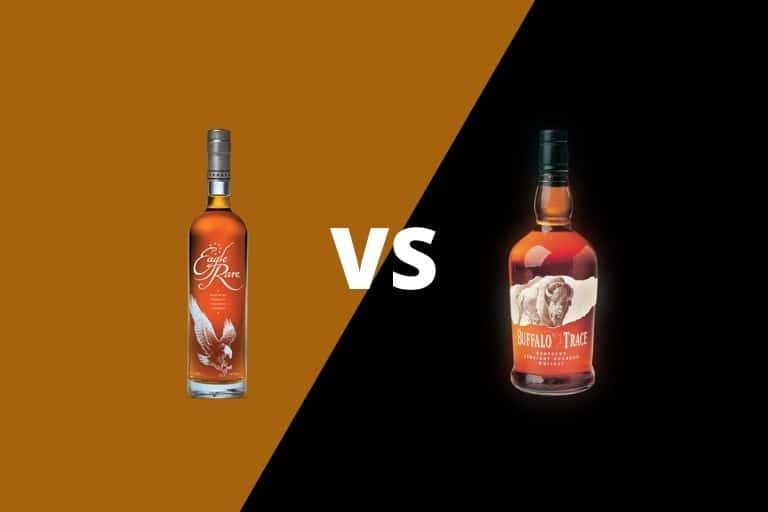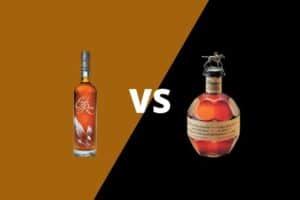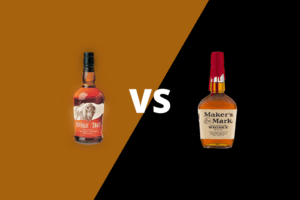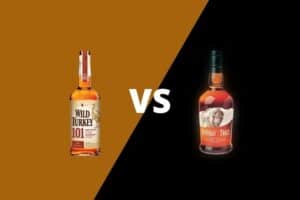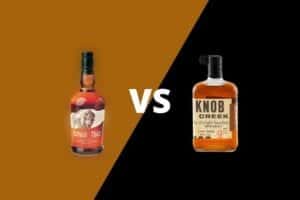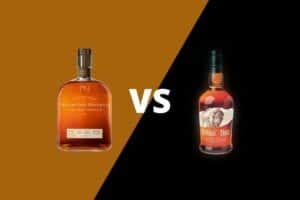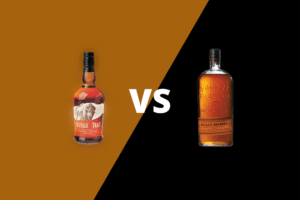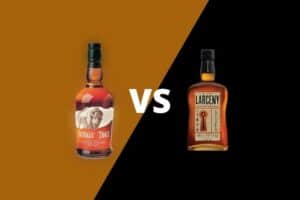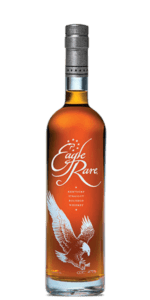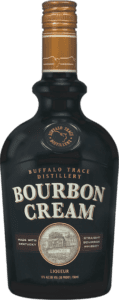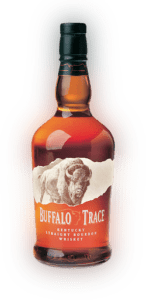This matchup pits two products produced by the same company against each other.
Both Eagle Rare and Buffalo Trace offer high-quality liquid for the suggested retail prices — but finding them at those prices is a different matter. And both are well respected by seasoned drinkers throughout the American bourbon scene.
But their availability constraints, different pricing segments and varying age statements leave us much to look into. So, let’s dive in and take a look at what these two amazing bourbons have to offer.
Table of Contents
History
The Sazerac Company is an entity whose origins begin in the mid-1800s in New Orleans.
If you were surprised that a company focused primarily on producing Kentucky bourbon began in New Orleans, you may be amazed by the vital role the Louisiana port town played in the origin of Bourbon whiskey.
The name comes from the royal Bourbon dynasty, represented by the ubiquitous fleur-de-lis flag. The French became really popular after they helped the American colonists during their fight for independence from Britain. So, the figures like the royal house of Bourbon and French general LaFayette were honored across the fledgling country — including the Kentucky frontier and French-speaking New Orleans.
There are a few origin stories about the term bourbon. The most widely-held notion is that the name comes from Bourbon County, Kentucky, where the spirit was first produced. This line of reasoning is tricky, though, because people were distilling in the territory before Kentucky became a state in 1792.
Other theories around the origination of the name for Bourbon whiskey revolve around the city of New Orleans.
Before the invention of the locomotive, the only viable way to bring spirits distilled in Kentucky to thirsty customers along the U.S. East Coast and abroad was to ship down the Ohio and Mississippi rivers to the delta port of New Orleans on the Gulf of Mexico. There, merchants purchased the bourbon and Rye whiskey barrels that came down the Mississippi, rum from distilleries in the Caribbean and U.S. East Coast and wines and brandies from Europe.
It’s no wonder the port city’s nightlife flourished.
Some historians argue that barrels that paid for passage at an essential lock and dam transit on the Ohio River in Kentucky were stamped with the name ‘Bourbon’ — which made an impression on the population of French descendants in New Orleans. Others believe the term came from the raucous parties the spirit fueled on the city’s Bourbon Street.
No matter which notion you subscribe to, the tale is a little bit Kentucky and a little bit New Orleans. Which is also an excellent transition to the Sazerac company’s timeline.
In 1896, Thomas H. Handy purchased the Sazerac Coffee House and began selling and promoting its signature Sazerac cocktail — originally made with Sazerac De Forge Et Fils Cognac and bitters produced by local Antoine Peychaud.
The company grew through the decades and in 1989 purchased two bourbon brands from Seagram’s — Benchmark and Eagle Rare. Both were initially produced by Heaven Hill, with Sazerac acting as a Non-Distiller Producer — or NDP. But when the company purchased the George T. Stagg Distillery and renamed it the Buffalo Trace Distillery in 1992, it gave them the capacity to distill spirits for Eagle Rare and release some new brands.
Mashbills
Sazerac does not release the mash bills of its products. So, the specific grain ingredients used in both Buffalo Trace and Eagle Rare are unknown.
While it is common for spirits produced at the same distillery to use identical mash bills to increase efficiencies, it is far from uniform in practice. What’s more, Eagle Rare is a legacy brand — one that was originally produced and distributed by another entity. Often, these recipes exchange hands along with the rights to the brand. But again, that’s far from certain as well.
Recent expansions to Buffalo Trace Distillery’s production facility have seen the doubling of cookers and fermenters, allowing more beer to be distilled to meet incredible market demand for its popular brands.
Distillation & Production
Both brands take advantage of the Buffalo Trace Distillery’s modern equipment — including its huge column reflux still. The facility has recently gone through expansion renovation and has more work planned in the future. These efforts to increase capacity are in response to near chronic shortages for many of Sazerac’s products.
The most well-known example is probably the Van Winkle line of whiskeys. Pappy Van Winkle’s Family Reserve is a line that offers 23-year, 20-year and 13-year expressions. There are also Van Winkle Family Reserve Rye 12-year and Special Reserve 12-year expressions and an Old Rip Van Winkle 10-year bottling.
These products were initially produced at the old Stitzel-Weller plant in Kentucky, whose stills had subsequently gone quiet. With barrels aged two decades or longer, finding enough juice to fit the demand for the renowned brands became increasingly difficult. Rather than increase the cases produced by lowering maturation standards, Sazerac decided to continue to offer the product at the same price point in limited quantities.
This approach helps explain the overall Sazerac ethos to whiskey making.
Bourbon enthusiasts already know how hard it is to find many Sazerac products. Most of their portfolio is on allocation. In non-control states, this means wholesalers and retailers wait in line to gobble up products — including Eagle Rare, Pappy Van Winkle, Blanton’s Single Barrell, Sazerac Rye, W.L. Weller and many more— to offer them to customers at retail prices that are often 3, 4 or 5-times the original manufacturer’s suggested retail price. By contrast, bourbon drinkers who live in control-states flood lines for lottery tickets in hopes of winning one of the vaulted products offered at the actual MSRP. So many customers flood those lotteries that getting a bottle can feel like finding the golden ticket.
Maturation
Aged 10 Years.
The maturation of these two brands is the simplest way to differentiate between the stable-mates. In the case of Eagle Rare, it’s the 10-year age statement on the back label that tells the bulk of the story.
Eagle Rare Kentucky Straight Bourbon Whiskey has retained its 10-year age statement since Seagram launched it in 1989. It was released initially at 101-proof straight — a nod to Wild Turkey — and as a single barrel product. It is no longer a single barrel bourbon, its bottling strength has been reduced to 90-proof and, in 2014, the age statement moved from the front label to the back label. But so far, it has retained the 10-year statement despite severe shortages and overwhelming demand.
Buffalo Trace Kentucky Straight Bourbon Whiskey does not carry an age statement. It has stated the bourbon inside is about 4-years old.
Ownership & Brand Extensions
Both brands are owned by the Sazerac company, based in New Orleans, Louisiana, with a primary corporate campus in Louisville, Kentucky.
In addition to the Buffalo Trace Distillery in Frankfort — the company’s largest production facility — it also operates distilleries in Bardstown and Owensboro, Kentucky, as well as A. Smith Bowman in Fredericksburg, Virginia; Boston Brands in Lewiston, Maine; Popcorn Sutton in Newport, Tennessee; and Old Montreal in Quebec, Canada.
In addition to the cornerstone 10-year bottling, Eagle Rare also offers a 17-year expression and the Double Eagle Very Rare special release bottling.
Price Point & Value
The MSRP of Buffalo Trace bourbon is about $27 for a 750mL bottle. It is bottled at 90-proof, or 45 percent alcohol by volume.
The MSRP of Eagle Rare 10 Year is about $35-40 for a 750mL bottle. We think… The truth is it is hard to find. In fact, for this review, we ended up shelling out $130 plus shipping to get a bottle here. It was the cheapest we could find. Recent allocations of the 10-year were long gone in control states at the time of publication. Eagle Rare is bottled at 90-proof, or 45 percent ABV.
As a general rule, if you do find a bottle of Eagle Rare near MSRP in a bottle shop near you, we suggest snagging one for yourself or as a special gift to the bourbon lover in your life…
Tasting Notes
Buffalo Trace Bourbon
Description: In the glass, Buffalo Trace has a deep amber color, with excellent legs at 90-proof.
Nose: Complex aroma, with notes of oaky wood barrel flavors, leather, tobacco and vanilla.
Palate: Wide range of flavors. Bold spicy rye character with black pepper and walnut notes.
Finish: Spicy, earthy with lingering toffee and notes of cinnamon.
[Related: Complete Buffalo Trace Bourbon Review]
Eagle Rare Bourbon
Description: Gorgeous legs down the glass at 90-proof that belay a pleasant mouthfeel.
Nose: Oak, barrel char, drying tobacco leaves, leather, dark cherry, dried apricot, caramel, toffee.
Palate: Vanilla, caramel, marzipan, nougat, white chocolate, honey.
Finish: Lingering vanilla, butterscotch, chocolate, cinnamon, almonds and baking spice notes gallop into the sunset.
[Related: Complete Eagle Rare 10 Year Bourbon Review]
Because of their production similarities, placing these products side-by-side in a blind tasting offers a unique opportunity to taste the difference maturation can take on similar distillates. The oak flavors in the Eagle Rare should be more pronounced — see if you can pick them out!
Verdict…
These two brands are generally well respected throughout the bourbon industry.
Each is a great representation of the bourbon category in their respective pricing segments. For Buffalo Trace, you get a great go-to bourbon, one that is generally available and offers a lot of bang-for-buck in its price range.
The same goes for Eagle Rare. It is an extremely high-quality bourbon that offers incredible oak flavor — when you can find it at its suggested price. The bourbon community knows that Eagle Rare offers incredible returns, which is why the bourbon market often reflects higher prices. Because the secondary bourbon market is out of Sazerac’s control, the brand’s respect and credibility have risen among bourbon nerds for their efforts to keep this an affordable bourbon product.

